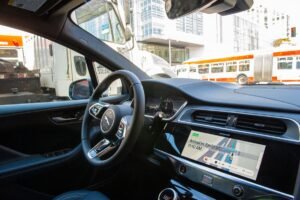When considering the advancement of state-of-the-art technologies, the Chinese government takes a practical approach to its policymaking process. In the realm of autonomous driving, the nation has made significant strides in defining parameters and limitations for service providers while eliminating regulatory ambiguity and allowing industry players the freedom to test this new technology.
The Chinese Ministry of Transport recently revealed a set of trial guidelines for autonomous vehicle services, including robotaxis, self-driving trucks, and robobuses. This announcement comes sixteen months after the department began soliciting feedback on the regulatory framework.
Prior to the adoption of these nationwide guidelines, policymaking for autonomous vehicles in China followed a more decentralized approach, with local governments establishing their own regulations for service providers within their jurisdiction. Tech hubs such as Beijing, Shenzhen, and Guangzhou have been pioneers in permitting companies to test AVs with minimal human intervention.
There are several noteworthy points to be gleaned from these new guidelines, and a closer look reveals notable differences in perspectives between Chinese and American regulators in regards to this burgeoning technology.
One of the guidelines specifies that regardless of their degree of automation, AVs may only operate within designated areas. For instance, autonomous buses should run on enclosed roads or those with simple conditions. This limitation is slightly more relaxed for robotaxis, which are permitted under controlled and safe traffic conditions. Robo trucks have the most explicit restrictions, allowing them to operate only on point-to-point highways or in good traffic conditions.
In addition to obtaining necessary permits for their AVs, operators must also obtain licenses required for public transportation service providers. The guidelines also call for clear labeling of AVs to notify other drivers on the road.
Furthermore, the guidelines make only one mention of software, stipulating that any over-the-air upgrades must adhere to regulations set forth by the Ministry of Industry and Information to ensure safety.
The rules also outline the requirements for safety operators at varying levels of automation. Autonomous cargo trucks should “in principle” have an in-car safety operator, while robotaxis with advanced automation should have one in-car safety operator. In the case of fully automated robotaxis operating in certain areas, remote safety operators may monitor up to three vehicles at a time.
Unlike American regulators, who mandate accidents involving AVs to be reported by operators, China takes a more top-down approach. According to the guidelines outlined by the Chinese Ministry of Transport, AVs are expected to continuously monitor and store vehicle status data, while also transmitting crucial information in real-time to both the service provider and local regulatory authorities. Additionally, service providers are required to have agreements with vehicle manufacturers and safety operators determining each party’s responsibilities in the event of an accident.
In the event of an accident, what information is expected to be provided? The regulations specify that AVs should record at least 90 seconds of event data, including the vehicle’s license plate number, control mode, location, speed, acceleration, and direction. Furthermore, the data must display the car’s perception of its surroundings and response, signal status, a 360-degree view of the environment, and any remote commands or malfunction diagnoses.
One notable difference from American policies is the requirement for in-car video and audio recordings of human behavior and interactions with the AV. Companies like Cruise and Waymo, on the other hand, only record video and activate audio in live support calls. The regulation of audio recordings in AVs should come as no surprise, given that Chinese ride-sharing services like Didi have recordings of in-car conversations.








